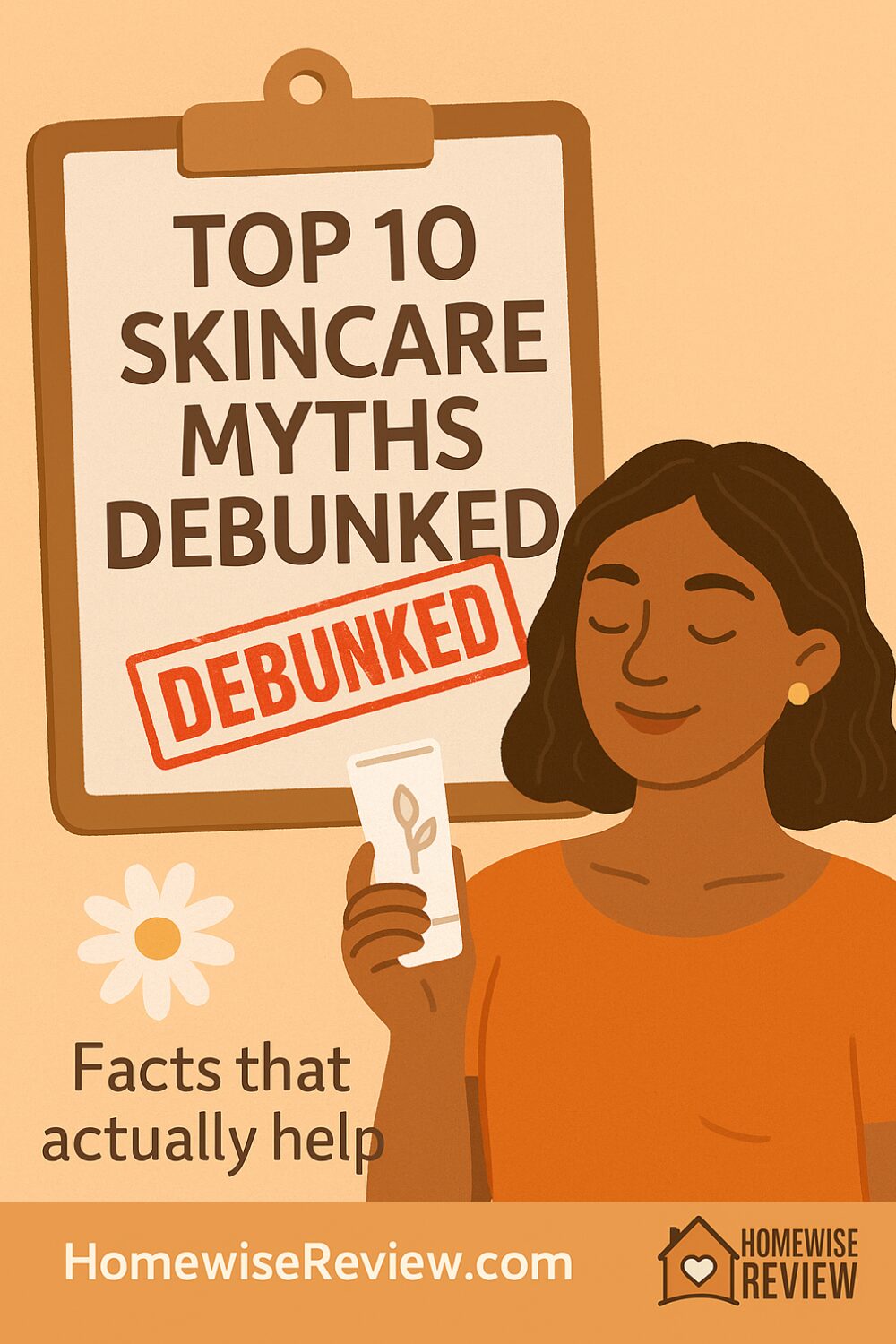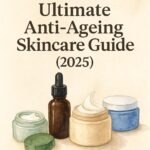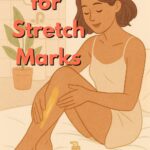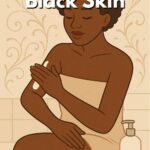
Introduction: Caring for your skin shouldn’t feel like decoding an old wives’ tale. Yet so many well-meaning tips get passed around that it’s hard to know what’s fact or fiction – especially for busy moms juggling family and self-care. One friend swears by a “base tan” for safety, another insists pricey creams are magic. Today, we’re cutting through the noise with ten stubborn skincare myths and the real truths behind them. In clear, friendly language, we’ll explain why even cloudy days demand SPF, why “natural” isn’t always safer, and more. By debunking these myths, you can save money, protect your skin’s health, and build a routine that actually works (without the hype). Let’s dive in – your skin will thank you!
Myth #1: You Only Need Sunscreen on Sunny Days
It’s easy to assume sunscreen is just for the beach or blazing summer sun, but UV damage is an all-year affair. Fact: Up to 80% of the sun’s UV rays penetrate clouds*, meaning even on overcast days your skin is at risk advantagederm.com. And don’t forget windows – aging UVA rays can pass through glass during your commute or sitting by a window. Daily incidental exposure adds up to wrinkles and spots over time. Make SPF a 365-day habit, rain or shine. (Even makeup with SPF isn’t enough – you’d need about seven times the normal amount of foundation for adequate protection!) The good news is modern sunscreens are lightweight and easy to wear. Find a daily broad-spectrum SPF 30+ you love.
Myth #2: Tanning Gives Healthy Color or a Protective “Base”
A tan might make you feel like you look healthy, but what’s really happening is skin cell injury. Dermatologists agree: there’s no such thing as a safe or healthy tan. Any bronzing of the skin is a sign of DNA damage as your body tries to shield itself. That “base tan” you got to prevent burning? It only provides an SPF of about 2-4 – essentially useless protection fda.gov. Also, tanning beds are not a safe alternative – they bombard you with concentrated UV rays and are linked to higher cancer risk aad.org. The truth is that tanning = premature aging and skin cancer risk, period.
Want vitamin D? Get it from diet or supplements – you don’t need to bake in the sun. And if you crave that sun-kissed glow, skip the UV altogether. Try a self-tanner or bronzing lotion for a safe faux glow instead. (In fact, many dermatologists recommend self-tanners as the healthy way to get some color.)
Myth #3: Oily Skin Doesn’t Need Moisturizer
“If my face gets greasy, I should dry it out – right?” Wrong! Even oily or acne-prone skin needs hydration. Skipping moisturizer can actually backfire by dehydrating your skin, which signals it to produce even more oil to compensate frontierdermatology.com. The result? A paradox of flaky-yet-shiny skin and potentially more breakouts. The truth is that a light, oil-free moisturizer will keep skin balanced. Proper hydration calms overactive sebaceous glands and supports your protective barrier. Opt for non-comedogenic lotions or gel creams (look for keywords like “water-based” or “hyaluronic acid”). They’ll hydrate without clogging pores. Remember: oily skin that’s well-moisturized often becomes less oily over time. Don’t be afraid to moisturize – just choose the right product (lightweight and no pore-cloggers) and your skin will be happier and more matte.
Myth #4: “Natural” Products Are Always Better for Your Skin
Nature gives us wonderful skincare ingredients – but it also gives poison ivy! In other words, “natural” doesn’t automatically mean safer or more effective. Many natural plant extracts can irritate skin or cause allergic reactions (essential oils are a common culprit). As one dermatologist quips, poison ivy is 100% natural, but you wouldn’t rub it on your face! The reality is that plenty of lab-made ingredients are rigorously tested and proven gentle – for example, lab-derived hyaluronic acid or ceramides can be skincare superstars. Meanwhile, unregulated homemade concoctions or certain organic products might lack preservatives, risking spoilage or irritation. Bottom line: judge a product by its actual ingredients and results, not just its “all-natural” label. Your skin doesn’t care if something came from a leaf or a lab – it cares whether the formula is right for your needs. (If you’re unsure about an ingredient, do a little research – our handy Ingredient Decoder guide breaks down common additives in plain English to help you make an informed choice.)
Myth #5: Expensive Skincare Products Work Better
It’s tempting to think a $300 luxury cream must be lightyears ahead of a $30 drugstore one. Truth is, price is not a reliable indicator of effectiveness. Often, that high price tag goes to fancy packaging, marketing, or luxury fragrances – not magical results. In fact, many affordable products use the same proven ingredients (like retinol, vitamin C, or niacinamide) that you’ll find in pricier lines. What really matters is the presence of research-backed actives and good formulation. A drugstore moisturizer with the right ceramides and peptides will beat an expensive jar of “fancy fluff” every time. Dermatologists suggest you read the ingredient list and be wary of over-the-top claims. Does it contain something science says works? If yes, great – no matter the brand name. By all means, treat yourself if you enjoy luxe products, but know you can get fantastic results on a budget. (For example, we’ve highlighted many budget-friendly favorites in our guide to the top beauty picks for busy moms – proof that you don’t need to overspend for great skin.)
Myth #6: Acne Comes From Not Washing Enough
Many of us grew up hearing pimples are basically due to dirt – if only we scrubbed harder, we’d have clear skin. Not so! Acne is not simply a hygiene issue, and over-washing can actually make it worse. Breakouts start deeper: excess oil production, blocked pores with dead skin, bacteria (P. acnes), and inflammation driven by hormones and genetics. While cleansing is important, you can’t scrub acne away. In fact, vigorous or frequent washing (more than twice a day) can strip skin’s natural oils, prompting more oil production in response. This can lead to increased clogging and irritation – the opposite of what you want. The truth: use a gentle cleanser (no harsh bar soap or gritty scrubs) twice daily at most. Be kind to your skin barrier. Treat acne with proven ingredients like salicylic acid or benzoyl peroxide rather than a rough washcloth. And remember, that occasional pimple isn’t because you’re “dirty” – it’s normal, and attacking your face won’t help. Gentle care and spot treatments will do far more good than any amount of scrubbing.
Myth #7: You Can Shrink Pores (or “Open” and “Close” Them at Will)
Who hasn’t stared at their pores in a magnifying mirror and wished they could make them vanish? Unfortunately, those tiny openings are determined mostly by genetics and skin type – you can’t permanently shrink pores with a toner or splash of cold water. It’s a complete myth that hot water “opens” pores and cold water “closes” them; pores don’t have muscles to open or shut on command realsimple.com. What about all those products claiming to minimize pores? The reality is you can make pores appear smaller by keeping them clear. Regular gentle exfoliation (like using a salicylic acid product) helps prevent clogs that stretch pores. Niacinamide is an ingredient known to visibly refine pore size over time. And yes, a good silicone-based primer can temporarily blur them. But no mask or strip can change your pore size permanently. Keep expectations realistic: focus on clean, balanced skin to make pores less noticeable. For example, cleanse off makeup each night and use non-comedogenic products to avoid enlarging pores with debris. Your pores might not disappear, but you can certainly stop obsessing – they’re likely far less visible to everyone else than they are to you.
Myth #8: You Should Exfoliate Daily for Smooth Skin
Exfoliation (removing dead skin cells with scrubs, acids, or peels) is great for glow – in moderation. But the myth that “if a little exfoliation is good, a lot must be better” can lead to real trouble. Over-exfoliating – every day or with harsh grit – can damage your skin’s protective barrier frontierdermatology.com. That outer layer (stratum corneum) is there to keep moisture in and irritants out. When you constantly scrub it away, skin can become dry, sensitive, and even prone to infection or breakouts from inflammation. Signs of over-exfoliation include redness, excessive peeling, or a stinging sensation when applying products. The truth is, most people do best exfoliating 1–3 times a week, depending on skin type. Gentle is the name of the game: for instance, a mild AHA serum or a soft rice powder scrub used occasionally will polish without stripping. On non-exfoliation days, focus on nourishing and protecting your skin (hello, moisturizer and SPF!). In fact, a balanced routine with regular hydration and sunscreen will do more for a radiant complexion than daily scrubbing ever could. (Need ideas for a gentler routine? See our guide to a simple, hydrating skin routine for tips on caring for your barrier while still getting results.)
Myth #9: Retinol Is Only for Winter (or Will Thin Your Skin)
Retinol (vitamin A creams like Retin-A/tretinoin and OTC retinols) is a gold-standard ingredient for wrinkles, texture, and acne. Yet there’s confusion that you must stop using it in summer or that it “makes skin thinner.” In reality, you can use retinol year-round – including summertime – as long as you pair it with sun protection. It’s true that retinoids make skin more sun-sensitive (they speed up cell turnover, exposing fresher skin), so you’ll want to be diligent with SPF. But the compound itself isn’t harmful in sunlight, and your results won’t vanish come June. Dermatologists simply recommend applying retinoids at night and wearing at least SPF 30 every day (which you should be doing anyway!). As for the thinning concern: retinol can cause some initial peeling or dryness on the surface, but over the long term it actually strengthens your skin’s deeper layers by boosting collagen. The key is to start slow (maybe every other night) and moisturize well to ease into it. Far from being a seasonal or dangerous product, retinol is a cornerstone of effective skincare – our own anti-aging guide highlights using a retinoid in your nightly routine for best results. Stick with it, protect your skin from the sun, and you’ll reap the rewards of smoother, firmer skin year-round.
Myth #10: You’ll Outgrow Acne After Your Teen Years
If only pimples came with an expiration date! Many people assume acne is just for adolescents, but adult acne is extremely common, especially for women. Hormonal shifts (think postpartum, menstrual cycles, perimenopause), stress, and even certain medications can trigger breakouts well into your 30s, 40s, and beyond. It’s not “because you didn’t wash enough” or any personal failing – often it’s just biology coming back for an encore. Dermatologists have seen a huge uptick in women over 25 presenting with acne for the first time, citing hormones, diet, and stress as main culprits realsimple.com. The takeaway? You might not simply outgrow acne, but you can treat it. Many adult acne patients find success with a combination of approaches: gentle cleansers, topical retinoids or benzoyl peroxide, and sometimes hormonal therapy (like birth control or spironolactone) to address internal causes. The silver lining is that some treatments pull double-duty – for example, the retinol you use for wrinkles also helps keep adult acne in check. And don’t be afraid to use makeup if it makes you feel more confident; just pick non-comedogenic formulas that won’t clog pores (our guide on finding the best foundation for acne-prone skin highlights options that cover blemishes while respecting your skin). Bottom line: breakouts can happen at any age. With the right care – and a dash of patience – you can manage them and still put your best face forward at 30, 40, 50 and beyond.




